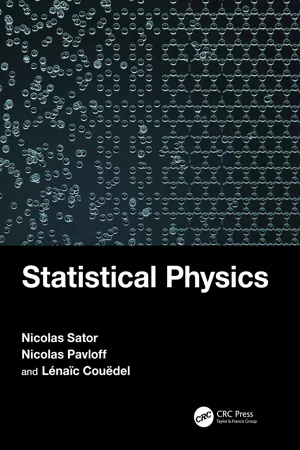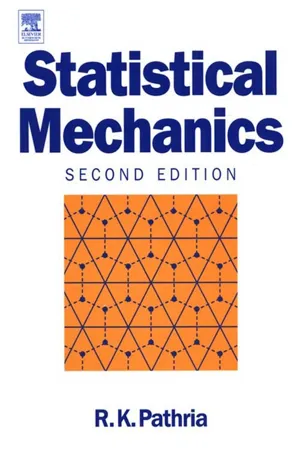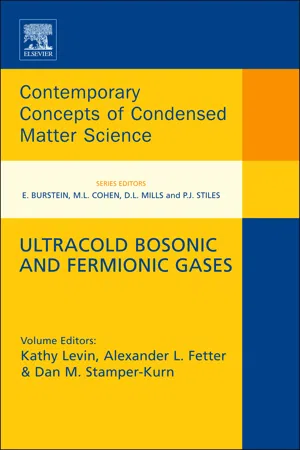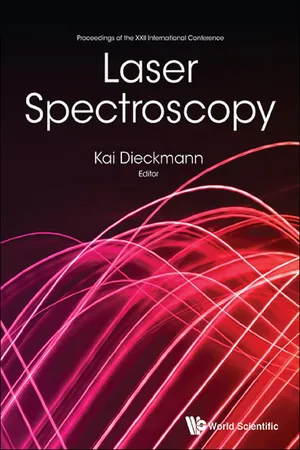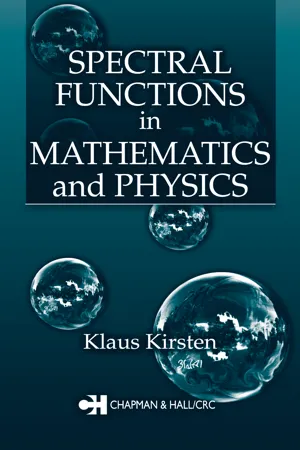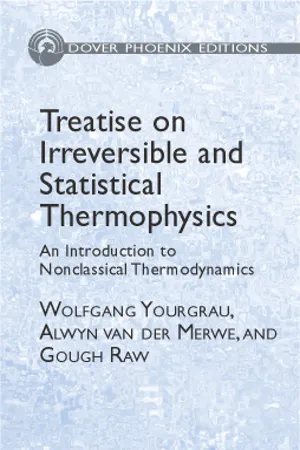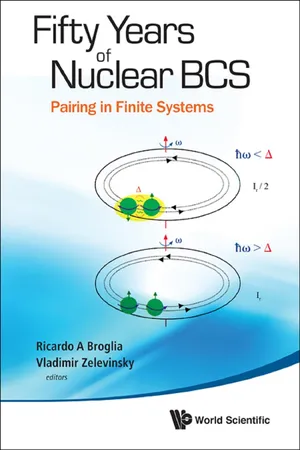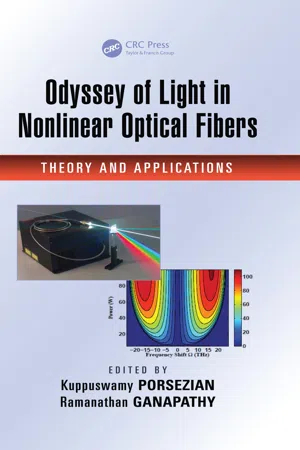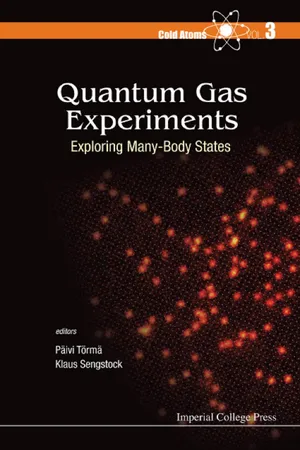Physics
Bose Einstein Condensate
Bose-Einstein condensate is a state of matter that occurs at extremely low temperatures. It is formed when a group of bosons, which are particles that obey Bose-Einstein statistics, collapse into the same quantum state, resulting in a single entity with unique properties. This phenomenon was first predicted by Satyendra Nath Bose and Albert Einstein in the 1920s.
Written by Perlego with AI-assistance
Related key terms
Related key terms
1 of 4
Related key terms
1 of 3
11 Key excerpts on "Bose Einstein Condensate"
- eBook - ePub
Evolution
Classical Philosophy Meets Quantum Science
- Somnath Bhattacharyya(Author)
- 2023(Publication Date)
- CRC Press(Publisher)
In condensed matter physics, a Bose–Einstein condensate (BEC) is a state of matter (also called the ‘fifth state’ of matter), which is typically formed when a gas of bosons at low densities is cooled to temperatures very close to absolute zero (−273.15 degrees centigrade, −459.67 degrees Fahrenheit). Under such conditions, a large fraction of bosons occupy the lowest quantum state, at which point microscopic quantum mechanical phenomena, particularly wave function interference, become apparent macroscopically. A BEC is formed by cooling a gas of extremely low density (about 1/100,000 part of the density of the normal air) to ultralow temperatures. The state was first predicted by Albert Einstein in 1925, following and crediting a pioneering paper by S. N. Bose on the new field, now known as quantum statistics. The result of this effort is the concept of a Bose gas, governed by Bose–Einstein statistics, which describes the statistical distribution of identical particles with integer spin, now called bosons. Bosons, particles that include the photon as well as atoms such as helium-4, are allowed to share a quantum state. Einstein proposed that cooling bosonic atoms to a very low temperature would cause them to fall (or condense) into the lowest accessible quantum state, resulting in a new form of matter. In 1938, fritz London proposed the BEC as a mechanism for superfluidity in helium-4 and superconductivity. Vortices in Bose–Einstein condensates are also currently the subject of analog gravity research, studying the possibility of modeling black holes and their related phenomena in such environments in the laboratory. Studies of vortices in nonuniform Bose–Einstein condensates, as well as excitations of these systems by the application of moving repulsive or attractive obstacles, have also been undertaken. Within this context, the conditions for order and chaos in the dynamics of a trapped Bose–Einstein condensate have been explored.BEC is the lowest-energy or the ground state of the bosonic system and has poor stability and can be easily distributed by perturbation. Vortices can be formed in the BEC, which can be described as the battle between the gods (bosons) and demons (fermions), having an integer and half-integer spin, respectively. The BEC looks like the fluid that remains still (state). Sankhya philosophy says Purusha remains (absolutely) static; however, it can be disturbed, leading to a state of nonequilibrium. Sankhya philosophy has also elaborated the interactions between static space and time (dynamics), which gives the distortion of space–time or uncertainty. Duality is always associated with nature and can be described by the uncertainty principle. - eBook - ePub
- Nicolas Sator, Nicolas Pavloff, Lenaic Couedel(Authors)
- 2023(Publication Date)
- CRC Press(Publisher)
14 Bose–Einstein Condensates of Weakly Interacting Dilute GasesDOI: 10.1201/9781003272427-14Since the middle of the 90's, it has been known how to trap and cool vapours of bosonic atoms (typically rubidium 87 Rb or sodium 23 Na) below the Bose–Einstein condensation temperature (see Section 7.4 ). These systems are very cold (T ~ 100nK) and exhibit strong quantum features. They are also inhomogeneous (because the gas is confined by an external potential) and subject to non-negligible interaction effects: the condensed atoms accumulate at the bottom of the trapping potential well until reaching relatively high densities1 at which the physical properties of the system cannot always be described by the non-interacting model considered in Section 7.4 . The system's low temperature is an asset for the theoretical treatment of the interactions because it is associated with a thermal wavelength that is larger than the typical distance between atoms2 : in this regime, it is legitimate to ignore the details of the interaction and to use a schematic potential, designed only to correctly describe the low energy scattering between two atoms. The simplicity of the resulting model enables to account, in the framework of a mean field approach, for non-trivial interaction effects for which it is possible to obtain precise experimental information.14.1 GROSS-PITAEVSKII EQUATION
The state of a Bose–Einstein condensate at low temperature is described by a complex order parameterϕ (which acts as the “wave function of the condensate”. As in Ginzburg-Landau theory of superconductivity (Section 10.5 ), a complex parameter enables to describe both the local density of the condensate (its modulus) and the current within the condensate [gradient of its phase, see Equation (14.70)]. It is customary to chose a normalisation such thatr →, t )| ϕ (is equal to the local densityr →, t )| 2n (r →, t ) - eBook - ePub
- Paul D. Beale(Author)
- 1996(Publication Date)
- Butterworth-Heinemann(Publisher)
4 The condition for the onset of Bose–Einstein condensation is(23)or, if we hold N and V constant and vary T ,(24)5 here, T c denotes a characteristic temperature that depends upon the particle mass m and the particle density N/V in the system. Accordingly, for T < T c , the system may be looked upon as a mixture of two “phases”:(i) a normal phase, consisting of N e {= N(T/T c )3/2 } particles distributed over the excited states (ε − ≠ 0), and(ii) a condensed phase, consisting of N 0 {= (N − N e )} particles accumulated in the ground state (ε = 0).Figure 7.1 shows the manner in which the complementary fractions (N e /N ) and (N 0 /N ) vary with T . For T >T c , we have the normal phase alone; the number of particles in the ground state, viz. z /(1 − z ), is O (1), which is completely negligible in comparison with the total number N . Clearly, the situation is singular at T = T c . For later reference, we note that, at T → T c from below, the condensate fraction vanishes as follows:(25)A knowledge of the variation of z with T is also of interest here. It is, however, simpler to consider the variation of z with (v /λ3 ), the latter being proportional to T 3/2 . For 0 ≤ (v /λ3 ) ≤ (2.612)−1 , which corresponds to 0 ≤ T ≤ T c , the parameter z 1; see eqn. (22) . For (v /λ3 )>(2.612)−1 , z < 1 and is determined by the relationship(26)6 see eqn. (8) . For (v /λ3 ) 1, we have: g 3/2 (z ) 1 and, hence, z 1. Under these circumstances, g 3/2 (z ) z ; see eqn. (10) . Therefore, in this region, z (v /λ3 )−1 , in agreement with the classical case.7 Fig. 7.2 shows the variation of z with (v /λ3 - eBook - ePub
- Kathy Levin, Alexander Fetter, Dan Stamper-Kurn(Authors)
- 2012(Publication Date)
- Elsevier(Publisher)
Contemporary Concepts of Condensed Matter Science , Vol. 5, No. suppl (C), 2012ISSN: 1572-0934doi: 10.1016/B978-0-444-53857-4.00002-7Chapter 2 Bose GasTheory and ExperimentAlexander L. Fettera , Christopher J. Footba Geballe1 Laboratory for Advanced Materials, Departments of Physics and Applied Physics, Stanford University, Stanford, CA 94305-4045b Clarendon Laboratory, Parks Road, Oxford OX1 3PU, United KingdomAbstractFor many years, 4 He typified Bose–Einstein superfluids, but recent advances in dilute ultracold alkali-metal gases have provided new neutral superfluids that are particularly tractable because the system is dilute. This chapter starts with a brief review of the physics of superfluid 4 He, followed by the basic ideas of Bose–Einstein condensation (BEC), first for an ideal Bose gas and then considering the effect of interparticle interactions, including time-dependent phenomena. Extensions to more exotic condensates include magnetic dipolar gases, mixtures of two components, and spinor condensates that require a focused infrared laser for trapping of all the various hyperfine magnetic states in a particular hyperfine F manifold ofmFstates. With an applied rotation, the trapped BECs nucleate quantized vortices. Recent theory and experiment have shown that laser coupling fields can mimic the effect of rotation. The resulting synthetic gauge fields have produced vortices in a nonrotating condensate.Keywords • dilute quantum gas • Bose–Einstein condensation • quantized vortices • exotic condensates • synthetic gauge potentials1 Introduction to Bose Superfluids: Brief Review of Superfluid 4 He
Superfluid 4 He has played a central role in understanding the physics of Bose–Einstein condensation. It has the unusual property of remaining liquid to T = 0 K under atmospheric pressure. This behavior reflects its weak interatomic potential and the relatively large zero-point energy (because of the small mass). The common helium isotope 4 He has two electrons, two protons, and two neutrons and thus acts like a boson under exchange of two such atoms. Below a characteristic temperatureTλ≈ 2.17 K, it undergoes a phase transition from a normal weakly viscous fluid to a superfluid with remarkable properties (for a review of this fascinating system, see [1] - Biman Bagchi(Author)
- 2018(Publication Date)
- CRC Press(Publisher)
However, an ideal Bose gas shows a fascinating phase transition, known as Bose-Einstein condensation (BEC) which has led to explanations of many quantum phenomena, ranging from superconductivity to superfluidity in liquid helium. We have the equation of state of a Bose gas written as, P V k B T = − ∑ i g i ln (1 − e − α − β ε i) 9.43 9.43 e − α = e μ k B T = z, where z is the fugacity of the gas. The equation of state can be rewritten. as P V k B T = − ∑ i g i ln (1 − z e − β ε i) 9.44 9.44 N = ∑ i 〈 n i 〉 = ∑ i g i e α + β ε i − 1 = ∑ i g i z − 1 e β ε i − 1 9.45 9.45 The summations in Eq. (9.44) and (9.45) are sum over the energy levels. Supposing we do a sum over states, then it is necessary that we give a statistical weight to each state. Since there is no restriction on the number of particles occupying a particular state, each state can be given a statistical weight of 1. So, the above two equations can be written as sum over all states P V k B T = − ∑ k ln (1 − z e − β ε k) 9.46 9.46 N = ∑ k 1 z − 1 e β ε k − 1 9.47 9.47 where the index k is for the states. Eq. (9.46) and (9.47) are the well-known expressions for a Bose ideal gas. The summation can be replaced by an integral by using the density of states g (ε) in the neighborhood of each energy level P V k B T = − ∫ d ε g (ε) ln (1 − z e − β ε) 9.48 9.48 N = ∫ d ε g (ε) 1 z − 1 e β ε − 1 9.49 9.49 For an ideal quantum gas, the density of states around each energy level. is g (ε) d ε = (2 π V h 3) (2 m) 3 2 ε 1 2 d ε 9.50 9.50 The equation of state of a quantum gas thus becomes P V k B T = − (2 π V h 3) (2 m) 3 2 ∫ 0 ∞ d ε { ln (1 − z e − β ε) } ε 1 2 9.51 9.51 Now consider the special limiting case when temperature T approaches zero Kelvin (0 K). In this limit, quantum effects are most pronounced. In this limit, β becomes very large, and exp(− βε) goes to zero unless energy ε is zero. Thus, the scheme of things in Bose gas, the zero energy state has a special significance. However, in writing Eq- eBook - ePub
Laser Spectroscopy
Proceedings of the XXII International Conference
- Kai Dieckmann(Author)
- 2016(Publication Date)
- WSPC(Publisher)
1(b), and the photon gas behaves equivalent to a two-dimensional gas of massive bosons that is harmonically confined, with the latter being caused by the curvature of the cavity mirrors. In contrast to a homogeneous two-dimensional Bose gas, Bose-Einstein condensation here is possible [ 24 ]. Interestingly, the effective mass where c denotes the speed of light in the medium and ω c the cutoff frequency, is some 10 orders of magnitude smaller than the mass of alkali atoms, and the Bose-Einstein condensation transition temperature can be at room temperature. In our experiment, an initial photon population is injected into the dye cavity system by pumping the dye with an external laser beam, either in a temporally pulsed or quasi-cw way. In the latter case, losses from the ’photon box’ can be compensated for by maintaining the molecular excitation level of the dye at a constant level. We have experimentally observed both the thermalization [ 25 ], as well as Bose-Einstein condensation of photons [ 11 ]. Figure 1(c) shows typical images for the emitted radiation transmitted through a cavity mirror below (left) and above the phase transition to a Bose-Einstein condensate (right). We observe photon gases with typically up to 70% condensate fraction very closely following expectations for a thermal equilibrium distribution. Evidence for a BEC of photons was obtained from the observed spectra showing Bose-Einstein distributed photon energies with a macroscopically occupied peak on top of a thermal cloud, the observed threshold of the phase transition showing the predicted absolute value and scaling with e.g. mirror curvature, and condensation in the trap center even for a spatially offset pump beam, as possible by the thermalization [ 11, 21 ]. 3. Nonequilibrium lasing versus equilibrium condensation of photons Trapped dilute cold atomic gas systems achieve a state that is very close to that described by a thermal equilibrium distribution [ 1, 2 ] - eBook - ePub
- Klaus Kirsten(Author)
- 2001(Publication Date)
- Chapman and Hall/CRC(Publisher)
Chapter 9Bose-Einstein condensation of ideal Bose gases under external conditions
We now turn to applications involving finite temperature theories. Here we have chosen to apply the techniques in a quantum mechanical system described by the Schrödinger equation9.0 Introduction(9.0.1)−Δℏ 22 mϕ k(+ Vx →)(x →)ϕ k(=x →)E kϕ k(,x →)ℬϕ k(x →)|= 0 ,x →∈ ∂ ℳwhere generallyVdescribes an external field and in addition we allow the possibility that the quantum mechanical particle is subject to some boundary-condition described by the operator B. We will not yet specify the boundary-conditions because the treatment to come will be quite general.(x →)One of the most characteristic features of such a system is the possible appearance of Bose-Einstein condensation. As mentioned in the Introduction, a series of new experiments [11 , 64 , 119 , 254 ] has renewed interest in ideal Bose-Einstein gases. The potentialVrelevant for the theoretical study of these experiments is the anisotropic harmonic oscillator potential(x →)which describes the magnetic traps used. As seen, the input for the potential is the mass of the atoms used and the frequency of the harmonic oscillator, all of which are determined experimentally.V(9.0.2)(=x →)ℏ m2(,)ω 1x 1 2+ω 2x 2 2+ω 3x 3 2Although we will restrict attention to the potential eq. (9.0.2) when providing explicit results, we develop the formalism under the general viewpoint of eq. (9.0.1) . For the description of the statistical mechanics of the system associated with eq. (9.0.1) we can use in principle three different statistical ensembles [41 , 251 ]. In the microcanonical ensemble the relevant partition function is Ω(N,E ), which denotes the number of microstates accessible to a N -particle gas with total excitation energy E. Formulated as a problem in partition theory, it is the number of possibilities for sharing the energy E among up to N - eBook - ePub
Treatise on Irreversible and Statistical Thermodynamics
An Introduction to Nonclassical Thermodynamics
- Wolfgang Yourgrau, Alwyn van der Merwe, Gough Raw(Authors)
- 2013(Publication Date)
- Dover Publications(Publisher)
In such a system, the injection of a particular number of molecules at constant V and T is occasioned by the condensation of an equal amount of molecules, thereby leaving the pressure of the vapor unchanged. The existence of this analogy, first remarked on by Kahn and Uhlenbeck (1938), explains why the word condensation is frequently used to describe the sudden crowding of bosons into the ground state when the temperature of a BE gas falls below T 0. The temperature T 0 is accordingly referred to as the condensation temperature. It should not be forgotten though that the resemblance to the condensation of a real gas is very limited: while the latter is due to intermolecular forces and occurs in coordinate space, the condensation of a BE ideal gas is a pure quantum phenomenon taking place in momentum space in the absence of any interaction between particles. The condensation of a BE ideal gas was first discussed by Einstein (1925), and is usually called after him. It may be stressed that this condensation at T ≤ T 0 is in marked contrast with the behavior of an FD ideal gas. Indeed, as we have already pointed out, the exclusion principle forbids the occupation of any quantum state by more than one fermion - eBook - ePub
Fifty Years Of Nuclear Bcs: Pairing In Finite Systems
Pairing in Finite Systems
- Ricardo A Broglia, Vladimir Zelevinsky(Authors)
- 2013(Publication Date)
- WSPC(Publisher)
μN, one obtains in this case:This is just the Schrödinger equation for the one-body problem describing the molecule. Indeed the general relation Φk = vk/uk, between the Fourier transform Φk of the molecule wave function Φ(r) appearing in Eq. (5) and the BCS coefficients appearing in Eq. (6) , leads in this case to vk= Φk On the other hand the (negative) chemical potential in this regime is indeed half the binding energy of the molecule, instead of being the Fermi energy as in the opposite very dense regime. Hence the BCS theory happens to describe also quite correctly this dilute regime where a Bose–Einstein condensation (BEC) of molecules occurs. This has been used by Keldysh and Kozlov4 to describe the Bose–Einstein condensation of excitons in semiconductors, which is quite analogous to the molecular BEC (naturally they considered the effect of increasing the density, since the very dilute regime is just solved by Eq. (8) ). Independently Eagles,5 investigating superconductivity in semiconductors, was led extrapolate the BCS formalism toward the dilute regime.The explicit consideration of the crossover between these two extreme regimes has been introduced by Leggett,6 who replaced g by the scattering length a to characterize the interaction. Nozières and Schmitt-Rink7 made later on, for this crossover, a detailed study of the evolution of the critical temperature Tc showing in particular how the ideal Bose gas Tc is recovered in the BEC limit. Sá de Melo, Randeria and Engelbrecht8 addressed later this crossover with a different formalism. Naturally, whereas in the very dilute and in the very dense regimes, the BCS description is exact (omitting some subtleties), it has been used in the crossover by these authors as a (quite reasonable) interpolation scheme. In particular one does not really know if there is a smooth crossover, or if a phase transition occurs somewhere between the two limits. The latter is the case in symmetrical nuclear matter for the BEC–BCS transition of deuterons,9 - eBook - ePub
Odyssey of Light in Nonlinear Optical Fibers
Theory and Applications
- Kuppuswamy Porsezian, Ramanathan Ganapathy(Authors)
- 2017(Publication Date)
- CRC Press(Publisher)
11 Matter wave solitons and other localized excitations in Bose–Einstein condensates in atom optics P. Muruganandam and M. Lakshmanan11.1 Introduction
Solitons belong to a special class of localized solitary wave packets which maintain their shapes and amplitudes owing to self-stabilization against dispersion through a nonlinear interaction [1 , 2 ] which arise as the solutions of a variety of weakly nonlinear dispersive partial differential equations describing physical systems. Study of such localized structures has been a central theme for evolution dynamics of many physical systems. In this context, considerable interest has been shown in exploring localized excitations in the variable coefficient nonlinear Schrödinger (NLS) equation and its generalizations [3 –5 ]. The motivation comes from the fact that the NLS equation and its variants appear in several branches/topics of physics, including nonlinear optics [6 , 7 ] and Bose–Einstein condensates (BECs) [8 –10 ], etc. The NLS equation and its generalizations have also been widely used in the nonlinear optics literature to describe the evolution of coherent light in a nonlinear Kerr medium, envelope dynamics of quasi-monochromatic plane wave propagation in a weakly dispersive medium, high intensity pulse propagation in optical fibers and so on.The experimental realization of BECs in dilute alkali-metal gases confined in magnetic traps has triggered an immense interest in studying the properties of ultra cold gases [11 , 12 ]. In particular, several attempts have been made by many experimenters worldwide to understand the properties of ultra cold matter and to exploit it for various purposes such as atom laser, atom interferometry, simulation of condensed-matter problems, quantum computing, information processing, and so on. An interesting dynamical feature is the formation of bright and dark matter wave solitons [13 –26 ]. Matter-wave soli-tons in atom optics are expected to be useful for applications in atom lasers including atom interferometry, coherent atom transport, and so on [27 ]. The behavior of a BEC crucially depends on the sign of the atomic interactions: dark (bright) solitons can be created in BECs with repulsive (attractive) interactions, resulting from the positive (negative) scattering length. The sign of the s-wave atomic scattering length changes by applying Feshbach resonance [28 –30 - eBook - ePub
Quantum Gas Experiments: Exploring Many-body States
Exploring Many-Body States
- Päivi Törmä, Klaus Sengstock(Authors)
- 2014(Publication Date)
- ICP(Publisher)
4 But why did experimentalists not make their lives easier, and work at both a higher density and higher temperature?For instance, at the density of air, about 2.5×1025 m−3 , one could reach quantum degeneracy at a temperature T ≈ 2 mK. Even more optimistic: at fixed pressure, cooling an ideal gas increases its density, so cooling a sample of argon at fixed atmospheric pressure could achieve quantum degeneracy at 0.5 K and n ∼ 1028 m−3 . Unfortunately, if you were to try this experiment, for instance with a dilution refrigerator, you would find that the gas simply freezes.In equilibrium, a nanokelvin sample of 87 Rb is a solid, not a gas.3 However, quantum gases are a metastable phase of matter. Measurements must be performed before the gas realizes that it “should be” a solid at nanokelvin temperatures. The lifetime of this metastable condition is given by the rate of three-body loss, the process by which three atoms are converted to a bound dimer and a free atom that carries away the binding energy. The rate of this loss process is Ln2 , where L ≈ 10−40 m6 /s for 87 Rb, for instance.5 ,6For a lifetime of 1 s, one requires n ≲ 1020 m−3 . This is five to eight orders of magnitude more dilute than the quantum gas achieved by the naive approaches described above. Instead, one is forced to work at extremely low density.While inelastic scattering gives an upper bound on practical density, elastic scattering bounds density from below. The elastic cross section between neutral atoms is roughly σ = 10−15 m2 . The collision rate for such a gas near quantum degeneracy is roughly 100 s−1 when the density is 1019 m−3 . This rate would allow for many elastic collisions during (for instance) a one-second-long experiment, enabling a thermal equilibrium between the translational degrees of freedom. Although it is understood that the molecular degrees of freedom are not described by a temperature (due to the slow relaxation rate at low density), we will describe the centre-of-mass position and velocity of the quantum gas by a temperature T
Index pages curate the most relevant extracts from our library of academic textbooks. They’ve been created using an in-house natural language model (NLM), each adding context and meaning to key research topics.
Explore more topic indexes
Explore more topic indexes
1 of 6
Explore more topic indexes
1 of 4

